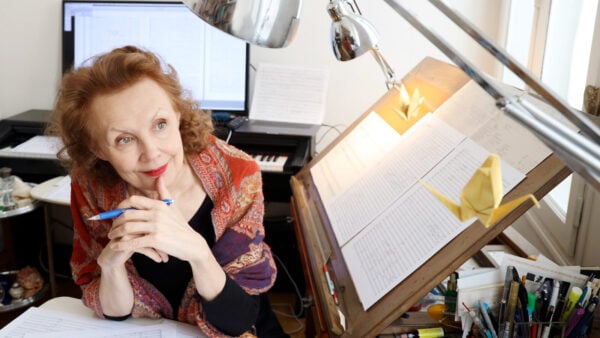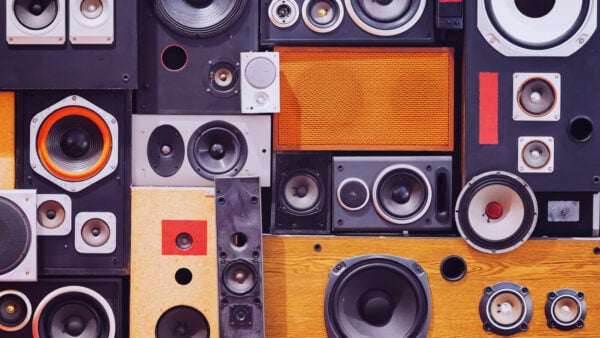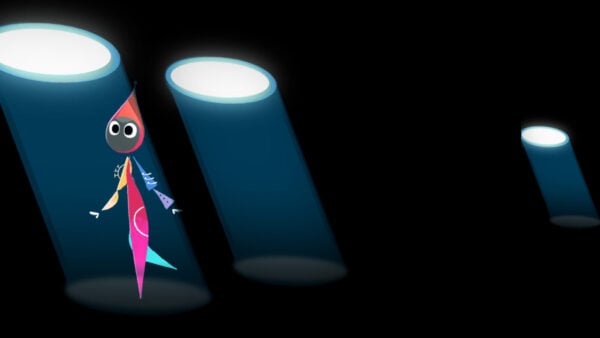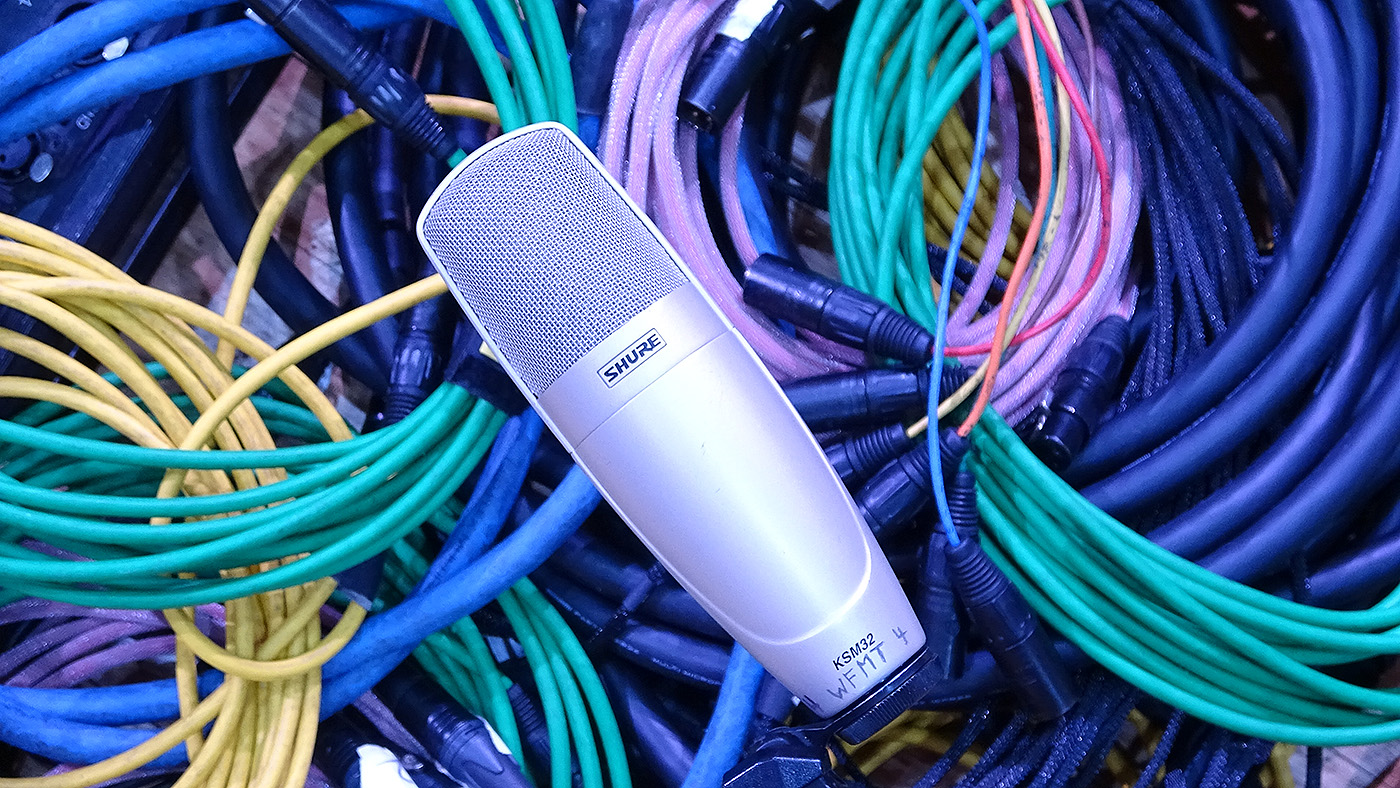
The rustling subsides as a request for silence is made over the public address system. I hear the click of the concert master’s heel on the stage, then applause. The traditional oboe concert A sounds as a hush falls over the crowd and the players begin to tune. Maestro Carlos Kalmar is greeted with enthusiastic applause as I see him enter the frame of the video monitor, ready to conduct the Oregon Symphony.
While the audience sits in the darkened Arlene Schnitzer Concert Hall, I sit under sterile fluorescent lights in a makeshift control/rehearsal room located above the percussion section. I am immersed in the glorious sound of Howard Hanson’s Symphony No. 4, which is being captured with many microphones and reproduced in 5.1-surround sound over high-fidelity speakers.
Seated in front of me is the president of Soundmirror, John Newton, recording the first of three live concerts. Next to him is producer Blanton Alspaugh following the score. And I am quite content to be there as a fly on the wall soaking up all of the stunning sonic detail: I am in the recording session for the symphony’s upcoming release on Pentatone.
Many music lovers enjoy their favorite music and musicians through recordings, but may not know how those recordings are made. Here’s a behind-the-scenes look at the “silent” work that goes into making classical recordings sound great.
Once upon a time, record labels would rally a team of A&R directors, engineers, producers, and distributors to realize an artist’s dream, but this has changed. According to Newton, that model hasn’t existed for more than 20 years. Soundmirror’s chief mastering engineer Mark Donahue adds that instead of a label production team, “We are hired by the orchestra or musical entity that runs the group.” This means that the financial responsibilities often lie solely on the artist or organization.
So, how much does it cost to record a classical album? Freelance producer Susan DelGiorno says that this can be difficult to asses because there are many variables to consider. She says, “You can make the same record many different ways.” Diplom Tonmeister and associate professor at McGill University Martha De Francisco says: “The absolute minimum to record an album would be $5000.” But this provides only the basics, as costs are usually much higher. Leslie Ann Jones, director of music recording and scoring at Skywalker Sound indicates that a solo piano or small ensemble recording might run in the range of $6000-7000, while an orchestra recording might start around $20,000, but adds that “the more people involved, the higher the cost.” However, with larger, on location recordings, Newton says that “musician costs, conductor fees, venue costs, costs for time and services” can all create additional expenses. David v.R. Bowles of Swinehead Productions, LLC says that an elaborate production could easily exceed $100,000.
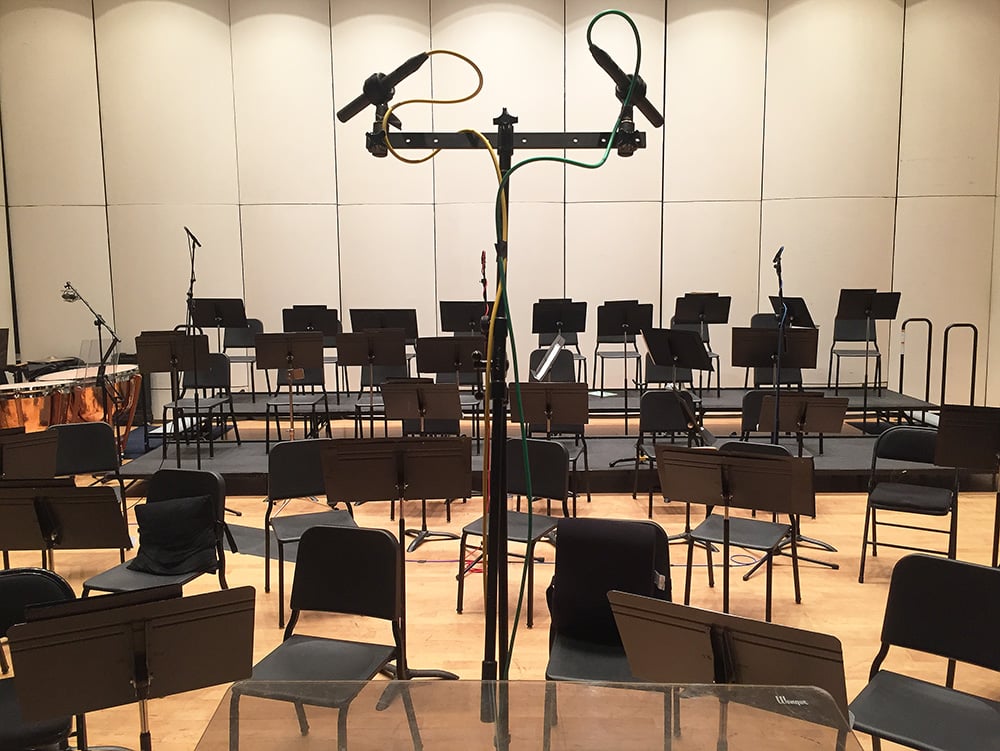
Part of my set up to record the Lake Forest Symphony at the James Lumber Center for the Performing Arts for the album Liquid Melancholy, with music by James Stephenson, on Çedille Records. The stereo pair in the front is set up to capture violas and cellos, while the microphones in the back will record timpani, brass, and winds
With such high costs, why make a record album at all? For one, Newton indicates that not all of the potential audience will attend the concert, and a recording is a way to reach those customers. De Francisco also notes that it allows the artist or ensemble to share their unique interpretation of the music, while Jones adds that a CD shows “serious intent and acts as a calling card.” Jim Ginsburg of Çedille Records agrees: “The physical album is still extremely important to classical artists as it gets them noticed in a way that a purely digital release cannot, including getting reviews in major publications, radio airplay, product to sell at concerts, and interest from concert presenters, conductors, etc. As one of our artists put it, the physical CD, ‘is our business card times 1000.’” In other words, it demonstrates seriousness and commitment to one’s music making, so it is essential for any professional musician. Christopher Willis of WFMT and C. W. Media explains that because musical performances are ephemeral, it is important to capture and share that beauty beyond the concert hall. A recording serves this purpose.
So artists need albums, and often have to pay to produce them. But where do they get the money? Performing entities, in current times, have had to become more creative and resourceful in this area. DelGiorno says that backing could originate directly from the artist(s), grants, public sponsors, or some combination of the above. Newton adds that labels might license the music to be used in other productions like movies or commercials, and this might help to recoup some of the costs. Crowdfunding has also become a popular means of raising the necessary cash. For example, Chris Willis and I worked on an album that was entirely realized as a result of one of these campaigns.
In addition to financial planning, there are other practical and logistical matters to consider before a recording is made. Scores need to be evaluated. Ginsburg says that he prefers to listen to recordings of the works performed by the actual artist(s) he is working with. If that doesn’t exist, there are more often then not, other commercial recordings or online videos of the pieces. De Francisco prefers, in most cases, to play the score on the piano herself, however.
A recording venue must also be selected. Among the choices are recording studios, concert halls, and churches. De Francisco prefers the acoustics of an actual hall or church to a studio, and will often seek out one that specifically complements the performance. Noise is a concern, so she typically asks, “Is there airplane noise, or traffic? Is there a subway nearby?” DelGiorno also prefers the ambient sound of an acoustic space to a studio but indicates that the budget is a big factor in choosing the location.
Besides the purely logistical preparations, DelGiorno wants to build a relationship with the artist. This is the instinctual part of producing, which she explains, yields the best performance outcome.
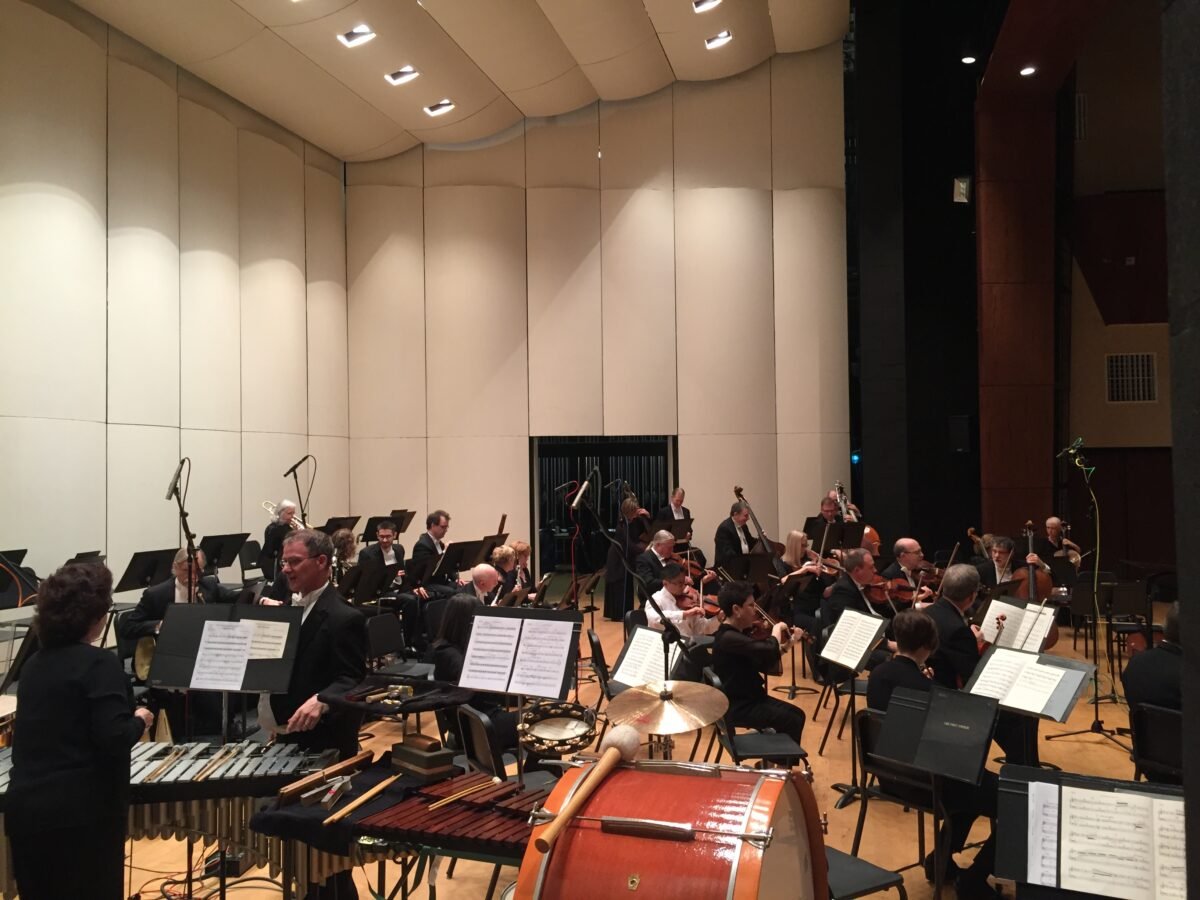
The Lake Forest Symphony getting ready to record James Stephenson's Liquid Melancholy for Çedille Records
But all of this careful planning still requires the right equipment to record everything. This is where the engineer comes in. The engineer is tasked with finding the right equipment to complement the instruments and repertoire, and to capture sound with a finesse and fidelity that presents the audience with the “perfect” listening perspective.
Bowles says the equipment might include microphones, cables, microphone stands, an audio interface, and a computer to capture the audio digitally. The computer, software, and interface make up a system known as a Digital Audio Workstation or DAW. You might think of a DAW as a canvas or, as Willis describes, as a camera in high-definition photography.
State of the art digital technology is used to capture music in high resolution. Donahue notes that Soundmirror was an early adopter of this method of recording dating back to 1979, but adds that the technology evolves rapidly, and must be continuously updated. Lawrence Rock, audio director of the New York Philharmonic, also an early adopter of digital recording technology, notes its importance but says that the most prized possessions of an engineer are their microphones. He explains, “Of all the equipment recording people use, there’s only one type of gear that doesn’t become utterly worthless, and that is the microphone. All digital, all computers, recording media eventually become absolutely useless, but microphones always retain their value.” This makes them useful tools, but the “fun” as Rock puts it, “is to use technology to capture music.” That is its true purpose. Again, if you think of the digital audio workstation as the canvas, the microphones are like the artist’s palette offering subtle auditory color variation so that the subject matter – be it a soloist or large orchestra – is portrayed at its best. After all, the music and musicians are the key reason recording exists.
In present times, personnel is generally streamlined for recordings. De Francisco says that she prefers to produce, but sometimes she takes on the roles of both engineer and producer. Ginsburg notes that he usually serves as the producer on Çedille releases, working with his staff engineer, Bill Maylone. Çedille also employs a production manager, who oversees scheduling; a development director and coordinator, who oversee the offices and sales; a finance manager, and a social media coordinator. But during the recording process, there will always be an engineer, a producer, or producer/engineer, and maybe a recording assistant. If the recording is taking place in a union venue, there will likely be stage crew, technicians, and electricians involved as well.

Part of my microphone set up to record Liquid Melancholy by James Stephenson for Çedille Records, which includes microphones on stage and off stage - including the four main microphones picking up the sound of entire orchestra.
The preproduction aspects are complete, the venue has been selected, and the personnel are in place. How long does it take until the album is released? Newton indicates that for an orchestra, performances are typically recorded, then followed by a patch session for corrections right after the final concert. Jones says that the editing could take a few weeks. However, depending on who is involved in the approval process and the number of requested revisions, editing could take much longer. The purpose of the editing process is to join the best takes together to make a full performance, but DelGiorno stresses, “imperfections are not necessarily a bad thing. The performance is what’s key.”
After the edits have been approved, the album needs to be mastered. Donahue describes the process as “the last step in the creative process and the first step in the manufacturing process” with the goal of, “making the recordings fit onto a single record.” He uses the analogy of photo retoucher to clarify the procedure. As with other aspects of the recording process, the total time varies greatly. Ginsburg shares his approach for planning: “The shortest turnaround time from the start of recording to release for us would be nine months. These days, we’re planning projects much further out to allow time for raising funds, executing an effective promotional campaign, etc. So we are planning projects as much as three years out at this point.”
Releasing a classical record album is a feat that requires endurance and determination for all involved but with the behind-the-scenes aspects often going unnoticed, what makes these men and women do what they do to help an artist or ensemble realize their dream? For Bowles it’s a matter of pride and personal challenge, “It means holding yourself to high standards and updating those standards by taking on challenging projects.” DelGiorno says, “There is real joy in helping others realize their creative vision.” For De Francisco, it is a “huge passion. It gives me so much satisfaction to be so close to the creation of art.” It is clearly a labor of love.
Author Mary Mazurek is a staff engineer and producer for WFMT. She has worked on many broadcast and record releases over her 25-year career.


